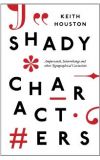
04 Oct 2013 02:38:37
As Keith Houston points out in his notes for further reading, there is already an indispensable guide to the history of punctuation – Malcolm Parkes's Pause and Effect: Punctuation in the West. That book, as Houston acknowledges, is "probably the single most useful work on the origins of modern punctuation", though, as he also rightly suggests, it does rather dispense "with such niceties as readability, accessibility, and pleasing design". Houston's book, in contrast, is highly readable, certainly "accessible" and very pleasing in design, though it is perhaps a work of enthusiasm rather than of scholarship.
Parkes, who died earlier this year, was professor of paleography at Oxford and devoted his life to the study of handwritten manuscripts: Pause and Effect was his magnum opus. Houston, according to his website, writes "medical visualisation software" by day and likes to cycle and play bass in a band by night: Shady Characters is his first book. For serious students, it might serve as a useful prequel to Parkes. For the rest of us, it's a perfectly pleasant alternative: Punc Lit Lite™.
Houston discusses 10 major typographical marks or groups of symbols: the pilcrow (¶), the interrobang (‽), the octothorpe (#) the ampersand (&), the @ symbol, the asterix and the dagger (* and †), the hyphen (-), the dash (—), the manicule (☞, ☜, and ☝ or ☟), and quotation marks of various kinds (" ", ' ', and ).
For good measure he also throws in a chapter on irony marks, including the recent doomed Dutch zig-zag ironieteken (which unfortunately resembles the insignia of the SS), and other miscellaneous forms of snark-marks, snigger points and digital sarcasm, such as :=\
As a primer on punctuation Shady Characters seems accurate, if at times perhaps rather overfamiliar and obvious, in that bloggy, blokey "accessible" manner that has now become the default mode in much popular non-fiction. "The orthographic world of ancient Greece was a sparse old place." "Printing … fundamentally and permanently changed writing and punctuation." "The quotation mark is quietly competent, thank you very much, and would like to be left alone to get on with things."
But the book's main purpose is not to provide a complete chronology or history – we have Parkes for that – but rather to draw attention to certain marginal and redundant marks such as the mighty pilcrow. The pilcrow – for anyone who finds, say, a semi-colon recherché, and who might therefore need reminding – is that fat old flamboyant paragraph mark that looks like a disorientated, red-nosed P, and which is now to be found almost solely in the prayer books of the Church of England, as an occasional proofreading symbol, and as what Houston calls a "boutique" character used to bring a retro feel to any printed or published work – the typographical equivalent of a fedora or a chiffon scarf.
Houston is at his best when dealing with the boutique, the fun and the funky. The chapters on the history of hyphens and quotation marks are as interesting as any chapters on the history of hyphens and quotation marks could possibly hope to be: the chapters on the interrobang and the @ symbol are entertaining as well as informative; and the chapter on the history of the anthropomorphic manicule, with its ever-insistent finger and fist, is a must-read. ☜
The interrobang, which is used to indicate a surprised or rhetorical question, and which is arguably the laziest, ugliest and stupidest punctuation mark ever invented, turns out to have been dreamed up in the 1960s by a New York advertising executive, Martin K Speckter. He struck lucky with the interrobang – a mix of the exclamation and question marks – which made a brief appearance on American Remington typewriter keyboards before disappearing.
The @ symbol, on the other hand – which is not a punctuation mark, as Houston notes, but rather "a logogram or grammalogue", a form of shorthand notation – was transformed overnight from its mundane and rare old usage as a mark meaning "at the rate of" into its current global ubiquity by a computer engineer working on the US government's ARPANET, the earliest iteration of the internet, in the early 1970s.
And so what, one might reasonably ask? Isn't a book about obscure punctuation really only a book for the connoisseur – about as useful and interesting as a history of lace embroidery, say, or pillow-slips, or Toby jugs, a weird collection of typographical bibelots and gewgaws? To which one might reasonably reply: no. Punctuation is not merely an ornament. Nor is it, as Houston's title wrongly implies, a curiosity.
It is not a garnish that we sprinkle on our sentences: it is an essential ingredient, a part of the complex and evolving technology of writing and printing, whose history both reflects and determines how we have expressed and defined ourselves as sentient, scribbling beings.
Shady Characters is certainly a handsome little object. It's also a timely reminder that we are all now in possession of punctuation in a way we never have been before. The box is open: all the tools are at our disposal. As Houston notes, "personal web pages have democratised typesetting in a way unimaginable to Gutenberg." Punctuation is no longer the preserve of the printer or the scribe. Every man his own priest. Every man his own typesetter. We are all Gutenbergs now.

